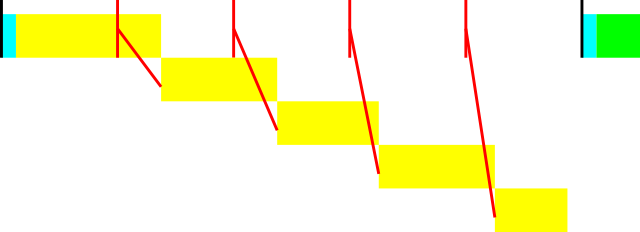Slowdown: Difference between revisions
(Created page with "Slowdowns are perceived during gameplay as slow picture updates (frameskip), this is only caused by the CPU not being able to update VRAM often enough to animate s...") |
mNo edit summary |
||
| Line 4: | Line 4: | ||
If calculations are too long and "overflow" to the next frame, the frame will be skipped. For example, if calculations last 16.8ms, a whole frame will be skipped because the CPU was 0.1ms late. | If calculations are too long and "overflow" to the next frame, the frame will be skipped. For example, if calculations last 16.8ms, a whole frame will be skipped because the CPU was 0.1ms late. | ||
Games known for having slowdowns are: | |||
*[[Aero Fighters]] | |||
*[[Blazing Star]] | |||
*[[Metal_Slug_2_-_Super_Vehicle-001/II|Metal Slug 2]] | |||
*[[Shock Troopers]]... | |||
*[[Twinkle Star Sprites]] | |||
In the following graphs: | In the following graphs: | ||
Revision as of 12:03, 29 December 2016
Slowdowns are perceived during gameplay as slow picture updates (frameskip), this is only caused by the CPU not being able to update VRAM often enough to animate sprites smoothly.
If a game wants to run at a constant 60 FPS (no frameskip), the calculations for a frame need to last less than 1/60 = 16.7ms. For 30 FPS (1/2 frameskip), they need to last less than 1/30 = 33.3ms.
If calculations are too long and "overflow" to the next frame, the frame will be skipped. For example, if calculations last 16.8ms, a whole frame will be skipped because the CPU was 0.1ms late.
Games known for having slowdowns are:
In the following graphs:
- The vertical lines are frame ticks given by the GPU, they always occur every 16.7ms (60Hz)
- Black lines are updated frames (different from the last one)
- Red lines are skipped frames (same as the last one)
- Cyan areas are the vblank periods, during which the CPU updates VRAM
- Green zones are CPU calculations not causing frameskip
- Yellow zones are CPU calculations causing unwanted frameskip
60 FPS engine
No slowdown
If CPU calculations are always shorter than 16.7ms, each and every frame is updated.
Slowdowns
If CPU calculations are longer than 16.7ms, the next frame is skipped. Multiple consecutive frames can be skipped (see Perceived slowdown).
30 FPS engine
The game's engine voluntarily updates one frame out of two, making the game run at 30 FPS at best. Note that the GPU always runs at 60.
Has the advantage of giving a more consistent framerate if the game tends to often exceed the 16.7ms limit, at the expense of more pronounced slowdown if it occurs.
No slowdown
If CPU calculations are always shorter than 33.3ms, one frame out of two is updated.
Slowdowns
If CPU calculations are longer than 33.3ms, one or two frames are skipped. Multiple groups of frames can be skipped (see Perceived slowdown).
Some game engines might be smart enough to "resync" and skip only one frame if they detect one was already accidentally skipped (doesn't rely on the LSB of a frame counter).
Perceived slowdown
Skipping one or two frames from time to time is rarely perceived or felt by the player. Annoying slowdowns occur when the video appears to stall.
Perception of slowdowns depends on the spreading of updates:
- #-#-#-#-#-#-#-#- is 30 FPS, acceptable.
- ########-------- is also 30 FPS, but very bothering.
Game engine logic
Are there game engines stupid enough to try catching up on each and every frame, instead of skipping some ?





